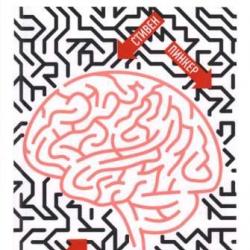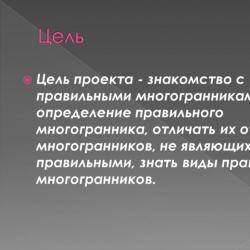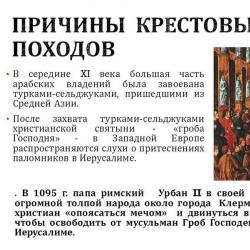Give examples of the manifestation of the law of mutual induction of excitation and inhibition. Law of Mutual Induction Manifestation of the Law of Mutual Induction
The activity of the cerebral cortex is subject to a number of principles and laws. The main ones were first established by I.P. Pavlov. At present, some provisions of the Pavlovian teaching have been clarified, developed, and some of them have been revised. However, in order to master the basics of modern neurophysiology, it is necessary to become familiar with the fundamental provisions of Pavlov's teaching.
Analytical-synthetic principle of higher nervous activity.
As established by I.P. Pavlov, the main fundamental principle of the cerebral cortex is the analytic-synthetic principle. Orientation in the environment is associated with isolating its individual properties, aspects, features (analysis) and combining, linking these features with what is beneficial or harmful to the body (synthesis). Synthesis is the closure of connections, and analysis is an increasingly subtle separation of one stimulus from another.
The analytical and synthetic activity of the cerebral cortex is carried out by the interaction of two nervous processes: excitation and inhibition. These processes are subject to the following laws.
The law of irradiation of excitation. Very strong (as well as very weak) stimuli with prolonged exposure to the body cause irradiation - the spread of excitation over a significant part of the cerebral cortex.
Only optimal stimuli of medium strength cause strictly localized foci of excitation, which is the most important condition for successful activity.
The law of concentration of excitation. Excitation that has spread from a certain point to other areas of the cortex, over time, is concentrated in the place of its primary occurrence.
This law underlies the main condition of our activity - attention (concentration of consciousness on certain objects of activity).
When excitation is concentrated in certain areas of the cerebral cortex, its functional interaction with inhibition occurs, and this ensures normal analytical and synthetic activity.
The law of mutual induction of nervous processes. On the periphery of the focus of one nervous process, a process with the opposite sign always occurs.
If the process of excitation is concentrated in one area of the cortex, then the process of inhibition inductively arises around it. The more intense the concentrated excitation, the more intense and widespread the process of inhibition.
Along with simultaneous induction, there is a successive induction of nervous processes - a successive change of nervous processes in the same parts of the brain.
Only a normal ratio of excitation and inhibition processes provides behavior that is adequate (corresponding) to the environment.
The imbalance between these processes, the predominance of one of them causes significant disturbances in the mental regulation of conduction.
So, the predominance of inhibition, its insufficient interaction with excitation leads to a decrease in the activity of the organism. The predominance of excitation can be expressed in disorderly chaotic activity, excessive fussiness, which reduces the effectiveness of activity. The process of inhibition is an active nervous process. It limits and directs the process of excitation in a certain direction, promotes concentration, concentration of excitation.
Braking is external and internal. So, if some new strong stimulus suddenly acts on the animal, then the previous activity of the animal at the moment will slow down. This is external (unconditional) inhibition. In this case, the emergence of a focus of excitation, according to the law of negative induction, causes inhibition of other parts of the cortex.
One of the types of internal or conditioned inhibition is the extinction of the conditioned reflex if it is not reinforced by an unconditioned stimulus (extinguishing inhibition). This type of inhibition causes the cessation of previously developed reactions if they become useless under new conditions.
Inhibition also occurs when the brain is overexcited. It protects nerve cells from exhaustion. This type of braking is called protective braking.
The analytical activity of the cerebral cortex, the ability to distinguish objects and phenomena similar in their properties, is also based on the internal form of inhibition. So, for example, when an animal develops a conditioned reflex to an ellipse, it first reacts to both the ellipse and the circle. There is a generalization, a primary generalization of similar stimuli. But, if the presentation of the ellipse is constantly accompanied by a food stimulus and the presentation of the circle is not reinforced, then the animal gradually begins to separate (differentiate) the ellipse from the circle (the reaction to the circle slows down). This type of inhibition, which underlies analysis, differentiation, is called differential inhibition. It clarifies the actions of the animal, makes it more adapted to the environment.
What conditions are necessary for the development of a conditioned reflex?
How does reflex inhibition occur?
Multiple repetition and the occurrence of a temporary connection
As a result of systematic non-reinforcement of actions
1. How does the nervous system regulate the work of organs?
In the neurons of the nervous system, there are two main oppositely directed processes: excitation inhibition Excitation stimulates the organ to work, as if including it in it, inhibition slows down or stops this work. Thanks to these processes, the work of organs is regulated. This regulation is multilevel.
2. What is the essence of multilevel regulation? What was the significance of the discovery of I.M. Sechenov central braking?
As studies by I.M. Sechenov, the lower centers work under the control of the higher centers. They can inhibit many unconditioned reflexes (central inhibition) or enhance them. It is the centers of the cerebral cortex that send inhibitory signals to the spinal cord, and we do not withdraw our hand when we take blood for analysis.
3. What types of inhibition were discovered by I.P. Pavlov?
Continuing the research of I.M. Sechenov, I.P. Pavlov showed that there is conditional and unconditional inhibition.
4. Give examples of unconditional and conditional inhibition.
Unconditional, or congenital, inhibition. Imagine that you are doing something, like reading a book, and you are invited to dinner. You were presented with two incentives, the most important one is selected from them. If the book is very interesting, you may not hear the words addressed to you, since stimuli of little importance to you affect the inhibited areas of the cortex. There will be a different choice if you are hungry and the book is boring. Then the old activity will be inhibited and a new one will begin. Thanks to unconditional inhibition, the choice of activity is possible: with the beginning of one activity, another automatically stops (or does not start). Conditional or acquired inhibition. Conditioned inhibition includes, for example, the extinction of a conditioned reflex. If the conditioned signal is left without reinforcement, then the conditioned reflex will soon die out, and with prolonged non-reinforcement it can turn into a negative (inhibitory) conditioned connection. Thanks to these inhibitory connections, animals and humans learn to distinguish between similar stimuli. If the dog is fed after one call and not given food after two, then salivation will occur only after one call (after two it will not). Of course, this won't happen right away. At first, saliva will be separated into both stimuli, and only after a long training the animal will learn to correctly distinguish between signals.
5. In what cases is a negative (inhibitory) conditional relationship formed between a signal and behavior?
Conditioned inhibition is developed in cases where the conditioned reflex is not reinforced by the vital event that the conditioned signal warned about. Thanks to conditioned inhibition, it is possible to distinguish important signals from stimuli similar to them. IP Pavlov discovered the law of mutual induction: excitation in one center causes inhibition in a competing center, and vice versa. There is also sequential induction: excitation in one center after a while is replaced by inhibition, and vice versa.
6. What is a dominant and how does it manifest itself?
The behavior of animals and humans is regulated by needs. They retreat for a while after they are satisfied, then reappear. A.A. Ukhtomsky discovered the phenomenon of dominance: the emergence in the brain of a powerful temporary focus of excitation caused by some urgent need. Thanks to the dominant, the formation of a temporary connection between the future signal and the need that has arisen is facilitated, which favors the development of a conditioned reflex.
7. Give examples of the manifestation of the law of mutual induction of excitation and inhibition.
The light gray background around the black square appears white in contrast. There is no light irritation from the black square. In the corresponding cortical cells of the visual analyzer, an inhibitory process occurs, which, by induction, enhances the excitation process that arose in neighboring cells from the perception of a light gray background. The illusion of a brighter illumination of this background is created than it actually is. Second example. The monotonous quiet speech of the teacher in the classroom, not accompanied by a demonstration of visual aids or experiments and not containing vivid descriptions, very quickly tires schoolchildren, especially young children. Their attention becomes distracted. In the tired nerve cells of the speech-auditory area of the cortex, an inhibition process occurs, which, by induction, enhances the excitation of neighboring nerve cells of the visual, auditory and motor analyzers, caused by the action of weak stimuli: the child now notices the occasional creak of the desk, the rustle of paper from behind, coughing; examines his hands and objects lying on the desk, sitting in front of the students; sorts through any familiar things in his pockets or in his desk, etc. Orienting reflexes to extraneous weak stimuli are amplified precisely because the main stimulus - the teacher's voice - caused persistent inhibition in the speech-auditory area of the cortex. This is a simultaneous positive induction. As an example of sequential positive induction, the same fact with a boring lesson can be cited: after a long forced sitting in the classroom, even disciplined children and adolescents make quite noisy breaks. Prolonged inhibition of motor reactions was replaced by increased motor activity. Inductive relationships of the basic nervous processes also exist between the cortex and the nearest subcortex. With strong emotions (anger, fear, despair), the excited subcortex induces inhibition of cortical nerve connections by induction. This explains the lack of reasonableness of some actions of an emotionally excited person. The opposite is also possible.
1. Over the past 150 years, the statistics of human mortality from various diseases has changed a lot. Give examples of such changes and explain them. 2. Inin the body of vertebrates there are bones that do not have articular surfaces. why might they be needed? Give examples. 3. Some angiosperms bloom less frequently than the average lifespan of one individual. How can this be explained and what could be the biological meaning of this? 4. In many ecosystems there are organisms that no explorer (or people in general) has ever seen. However, in some cases the existence of such organisms can be proven. Suggest ways of proof. 5. Why might spontaneous death of healthy plant cells be needed? 6. What can happen to organisms that live in that part of the salt reservoir, which is forever separated from the main reservoir?
1. give an example of geographic speciation 2. with ecological speciation, unlike geographical, a new speciesarises...
3. macroevolution ends with the formation of new ..
4. The similarity of mammalian embryos proves..
5. Give examples of ecological specialization.
Urgent help 1. Different living organisms produce different numbers of offspring. Give examples.......2. Any living organism produces more children than it can survive. The causes of death of organisms are --- ......,.......,
3. All living organisms have to deal with unfavorable conditions for life. Give examples of unfavorable conditions - for plants -..........., for animals - ........., for humans - ...........
4. Everything that surrounds a living organism is called ...... , .... .
5 . In your experiment with seeds, those that developed under .....
conditions. The rest died.
7. Plants form organic substances from inorganic substances.
To do this, they need ......
8. The life of man and animals depends on plants, since ........ .
9. The life of plants depends on humans and animals. For example - ......... .
10. A person should know that all living organisms on Earth are connected with each other. Destroying some, he causes the death of others, endangering his own life. Give examples of human influence on living organisms in your area: a) a positive, in your opinion, influence. b) negative influence.
Work 176.
1. Explain how synapses work.
When nerve impulses reach the synapse along the axon, the vesicles with the irritating substance burst, and fluid flows into the synaptic cleft. Depending on its composition, the cell is excited or inhibited.
2. What is the essence of central inhibition?
This is an active nervous process that occurs in the central nervous system and leads to inhibition or prevention of excitation.
3. Fill in the table.
Work 177. Fill in the table.
Dominant The law of mutual induction of inhibition-excitation A powerful focus of temporary excitation in the cerebral cortex and other parts of the brain, caused by a strong need, is called dominant.
A need exists until it is satisfied or until another, stronger need displaces it.
According to the law of mutual induction, the dominant focus of excitation inhibits all other centers. The resulting excitation switches to the dominant focus, which is enhanced by it. The state of the dominant facilitates the development of reflexes.
excitation (or inhibition) that occurs in a particular part of the brain, in competing centers causes the opposite process. These are manifestations of the law of mutual induction.
In the same center, the same process cannot exist forever, therefore excitation in it is replaced by inhibition, and inhibition by excitation.
Intoxication causes a state of euphoria, which is replaced by melancholy and aggression, because. the level of glucose in the blood falls and the effect of "mutual induction" occurs.
Work 178. The phenomenon of the dominant is often used in art in the same way as the law of mutual induction of excitation and inhibition. Habitual images, ideas, fonts often create a fairly stable dominant that makes it difficult to form competing images or ideas.
1. Consider Figure 107 in the textbook. Why do many people not notice the figures of children playing, taking the images for the convolutions of the large hemispheres of the brain?
We see what we are used to seeing thanks to the formed dominant.
2. What allows us to see the figure of a rabbit in three four spots?
Postscript "silhouette of a rabbit".
3. Why is it difficult to see the figure of Napoleon in the figure?
Because the figure is hidden by the background of nature.
4. Why do people who clearly perceive the trees and the figure of Napoleon, these images appear sequentially, replacing each other, or one of them goes into the background?
According to the law of mutual induction.
When closing and opening the circuit, the current is not established instantly. The deceleration effect is determined by the inductance of the circuit. Let's find the dependence when opening and closing the circuit.

P  When the circuit is opened, the current decreases from the value
When the circuit is opened, the current decreases from the value  to zero and at the same time emf arises. self-induction
to zero and at the same time emf arises. self-induction  , which counteracts the decrease in current. At each moment in time, the current in the circuit is determined by Ohm's law:
, which counteracts the decrease in current. At each moment in time, the current in the circuit is determined by Ohm's law:
 .
.
Integrating the equation from  before
before  , we get:
, we get:

 ,
,
Where  - a constant having the dimension of time is called the relaxation time.
- a constant having the dimension of time is called the relaxation time.
The more  , the slower the current drops. During
, the slower the current drops. During  the current in the circuit decreases in
the current in the circuit decreases in  times (approximately 3 times) (see dependence 1 in the figure).
times (approximately 3 times) (see dependence 1 in the figure).

 .
.
Explore on your own.
The phenomenon of mutual induction. Mutual inductance. Ems of mutual induction.
E  If two electrical circuits are close, they can influence each other. Such circuits are called inductively coupled. Let's consider two such contours (see figure). If a current is passed through the first circuit
If two electrical circuits are close, they can influence each other. Such circuits are called inductively coupled. Let's consider two such contours (see figure). If a current is passed through the first circuit  then the magnetic flux coupled to the second circuit will be proportional to the current
then the magnetic flux coupled to the second circuit will be proportional to the current  , and will also depend on the mutual orientation of the contours, their geometric dimensions, the number of turns, and the magnetic properties of the medium. You can write:
, and will also depend on the mutual orientation of the contours, their geometric dimensions, the number of turns, and the magnetic properties of the medium. You can write:
 .
.
Here the coefficient  called mutual inductance second circuit depending on the first. Reversely, if you pass the current
called mutual inductance second circuit depending on the first. Reversely, if you pass the current  through the second circuit, then for the magnetic flux coupled to the first circuit, we can write:
through the second circuit, then for the magnetic flux coupled to the first circuit, we can write:
 .
.
For linear media, the coefficients  And
And  are equal to each other:
are equal to each other:
 .
.
Mutual inductance or inductance is measured in henries (H).
Mutual inductance  numerically equal to the magnetic flux coupled to one of the circuits, with a unit current in the other circuit. Mutual inductance depends on the shape, size and mutual orientation of the circuits, the magnetic permeability of the medium.
numerically equal to the magnetic flux coupled to one of the circuits, with a unit current in the other circuit. Mutual inductance depends on the shape, size and mutual orientation of the circuits, the magnetic permeability of the medium.
For example, the mutual inductance of two coils with a common core is:
 ,
,
Where  - the volume of the core,
- the volume of the core,  And
And  - the number of turns per unit length of the generatrix of the core for the first and second coils.
- the number of turns per unit length of the generatrix of the core for the first and second coils.
D  let's provide it. Let current flow on the first coil
let's provide it. Let current flow on the first coil  (see picture). For a sufficiently long coil, neglecting edge effects, we assume that the magnetic field in the core is uniform:
(see picture). For a sufficiently long coil, neglecting edge effects, we assume that the magnetic field in the core is uniform:
 .
.
The magnetic flux coupled to the second coil will then be equal to:
Where does the expression for  , considering that
, considering that  is the length of the core.
is the length of the core.
Note that the resulting relation for  is approximate and can be represented differently:
is approximate and can be represented differently:
 ,
,
Where  And
And  is the inductance of the coils.
is the inductance of the coils.
E  If an alternating current is passed through one of the circuits, then an induction current will appear in the second in accordance with Faraday's law.
If an alternating current is passed through one of the circuits, then an induction current will appear in the second in accordance with Faraday's law.
For example, if in the first circuit  , then the magnetic flux coupled to the second circuit will change over time
, then the magnetic flux coupled to the second circuit will change over time  and emf will appear in it. induction.
and emf will appear in it. induction.
 .
.
At  :
:
 .
.
Obviously,  .
.
The emf that occurs in the circuits is called emf mutual induction.
Direction of currents and emf mutual induction is determined by the Lenz rule (see figure)

The resulting inductive current in the second circuit  its magnetic field prevents the growth of the magnetic flux from the primary circuit.
its magnetic field prevents the growth of the magnetic flux from the primary circuit.

The resulting inductive current in the second circuit with its magnetic field prevents the reduction of the magnetic flux from the primary circuit.
The change in currents in inductively coupled circuits in linear media is described by Ohm's law:

Where  - emf sources in circuits 1 and 2,
- emf sources in circuits 1 and 2,  - circuit inductance,
- circuit inductance,  - mutual inductance of the circuits.
- mutual inductance of the circuits.
Note that the effect of transformers that serve to convert currents and voltages is based on the phenomenon of mutual induction.
R  Let's consider the idling of the transformer. This is the case when the secondary winding of the transformer is not loaded (see figure). In this case, you can write:
Let's consider the idling of the transformer. This is the case when the secondary winding of the transformer is not loaded (see figure). In this case, you can write:
 .
.
because  .
.
Neglecting the resistance of the primary winding of the transformer  , we estimate the voltage on the secondary winding:
, we estimate the voltage on the secondary winding:
 .
.
Transformers are used to increase or decrease voltage. For currents in the transformer windings, an inversely proportional dependence on the number of turns is observed:
 .
.
Justify yourself.






